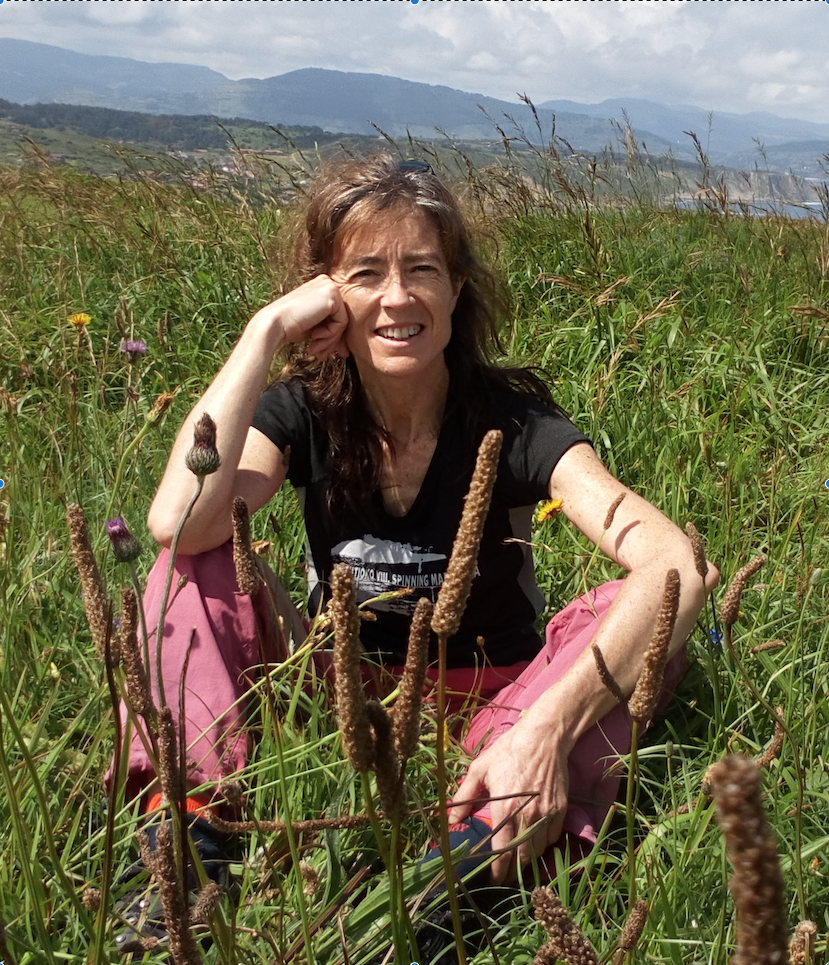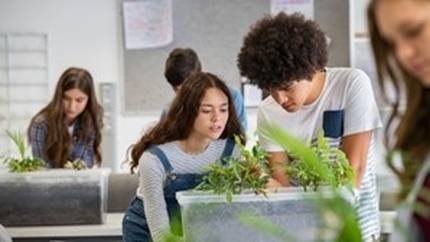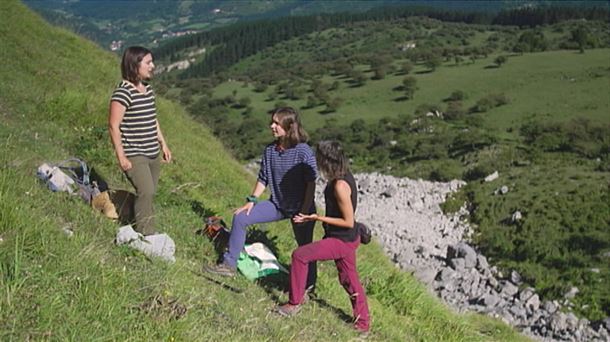"When talking about the meadow, the young people say, "Everything is the same, there is only grass!" We wanted to break this idea."
2024/05/29 Elhuyar
The 2nd and 3rd ESO students of the IES Talaia BHI of Hondarribia, together with researcher Arantza Aldezabal and the research group “FisioClimat-AgroSosT” of the School of Science and Technology of the UPV/EHU in Leioa, have analyzed the biodiversity and the vegetal blindness of the young people. The impact on biodiversity of work carried out in urban meadows or gardens has been analyzed.
 None
None
“FisioClimat-AgroSosT” is the name of your research team. Who are you in the group?
We are a very heterogeneous group. It consists of nine permanent faculty researchers from the UPV, four hired researchers and five doctors. From different fields of knowledge, on the one hand botanical, on the other hand plant physiology and, finally, ecological knowledge. In addition, we often work with other groups.
What do you do?
Our research is based on different rural agroecosystems. We call agroecosystems unnatural systems, which have some human activity. The rural landscape consists of food crops, semi-natural rural areas used by livestock and forests.
We try to analyze the interactions between the organisms that live there. To do so, we investigated soils, plant elements and animals that feed on them. We also studied the physiological functioning of plants. Sometimes we work in the agroecosystem itself and sometimes experimentally in greenhouses, especially to study a concrete physiological characteristic.
With the Mesa de los Gluones project you have brought your research project closer to schools. What has been the objective? What did you want to convey to the students?
In short, we wanted to convey that the conservation and biodiversity of rural areas depends on people. In this case, a rural field of rustic environment has been investigated, but the same study can be carried out in an urban garden. Both are characterized by their maintenance through human management, which affects the conservation and biodiversity of this prairie.
Furthermore, in principle, grasslands are not attractive. For example, a lot of pedagogy has been done around the forest. For example, in schools special days are organized to go to plant trees. I mean, the forest has a recognition. Grasslands don't. When they mention the meadow, the young people say, “Everything is the same, there is only grass!” We wanted to break this idea. In addition, I would like to make it clear that the meadow is much more accessible, closer and closer than the working forest.
What is keeping a prairie well?
If you stop managing a meadow, biodiversity is lost, but if you overload it too. Balance is needed.
Human beings often disregard biodiversity conservation in grassland management and are usually managed for productive purposes. For example, the baserritart will check the amount of grass it gives to feed the animals. In cities and towns it is intended to have beautiful gardens for people to be happy. What happens is that the nice garden for citizenship will be one that has a very short herb… Is that really taking care of a garden? To manage a prairie well, it is necessary to know it beforehand. This has been the starting point for the implementation of research at the centre.
What followed them?
First, we held a meeting with Elhuyar and the teachers of the center to explain the roles of each and adapt the discourse to the young. As university professors, giving clear explanations to the young people of ESO has been a challenge for us.
We started the first session with young people in class. We stand before them and ask them, what is a meadow? Through the questions we seek the involvement and participation of the students.
As has already been mentioned, firstly, we stress the importance of observation. They were explained that we will compare a meadow managed with a meadow that is not managed, in order to draw conclusions from that comparison and see what is the proper management.
I think we managed to convey the importance of asking concrete questions and hypotheses for observation, as well as the variables to which we will pay attention for measurement.
Once the theoretical height was achieved, we went to the grass to investigate.
Among all, we set experimental plots in the prairie, 4 pairs of plots of 5x5. Total 8 plots. We put them in different places on the prairie, because we realized that the meadow was very different from one corner to another. For example, one area has a higher slope than the other.
In another session, we performed the first sampling. All measurement kits were taken to this session. Elemental measurements were taken and the logistic mode of action was determined, as well as the rest of the exercises that were to be performed on their own in the same week.
Have you had to look at the saw for observation?
Samples have been collected in the soil and bugs have been observed, not so much in quantity, but in what type. This is what we call microfauna biodiversity. In parallel, physicochemical variables such as PH have been analyzed in the laboratory. Soil temperature and humidity were measured on the sampling day. CO2 emissions. The latter have done so in two ways: they simulate the night with a boat to see that the plants breathe and photosynthesis in daylight at the same time and only at night the breath.
Besides the soil, plant inventories have been made to see which species exist. They've made a herbarium of these plants, pressing them and drying them. These plants have been moved to our laboratory visit.
And finally, as plants flourish, they see pollinators. I mean, you've seen what kind of pollinators visit the flower. So you see the interaction between pollinators and plants.
With the latter, we wanted to stress that biodiversity means not only a large number of species, but also an interaction between them. These interactions are of great importance for grassland operation. Beyond plants, we have warned them of the interactions that are lost if a species is lost and its consequences.
What did they do when they came to their labs?
We wanted them to feel like lab technicians, and through a small protocol prepared for them, we measured the contributed plant samples: pigments and protein concentrations. It was very nice. The teachers told us they were very comfortable. In addition, PhD students were the collaborators, and the fact that they were young gave them more closeness.
What is the importance of carrying out such projects in schools?
You open the students up to a new world, because nobody has given them the opportunity to see what's in front of them. That is the world in itself and the emotions that nature conveys to them are recorded. Good and bad emotions. You had to see what fears and revolts some had with pollinators and sages. In short, they're experiences and emotions, and that's recorded.
On the other hand, it works a hidden potential and tells them that they are capable of carrying out such an investigation. Many young people rejoice to see that they have succeeded. Teachers also have to believe in that capacity that young people have. It is important to give this option.
Finally, the project allows them to transmit. If you're proud of your research and want to tell it, Elhuyar Zientzia Azoka is an opportunity. There is a big leap, because they show it in society. Moreover, by having to give explanations to the public, they do so responsibly. Feeling is also important.
And what do you give?
We see the need to do so in the centres. We have the feeling that when students come to us it is late. It is very important to convey love and respect for the environment from the school level. We regard it as a mission and therefore giving that opportunity is enormous. And also fun.
How important is the world of research and the contact of young people?
Because of this, researchers see that we're close people. We have tried to convey it. “Here we are to show you things, but we are also to learn from you.” They have gradually gained confidence and have come closer and closer to asking questions.
Besides, outside the classroom, working in the field gives you naturalness, because you come up with questions that you didn't think about in class and you improvise the examples instantly.
What has been the involvement of teachers?
It is essential and they have made an effort out of their daily lives.
On the one hand, they worked with the students in advance to explain the context. For example, they reminded them what photosynthesis is.
On the other hand, we passed the list of plant species and created plasticized tokens to make them more attractive. Currently there are mobile applications that tell you about the plant at the time. However, we have tried to use as few digital tools as possible, avoiding mobiles and collecting data manually among young people.
They have also thanked us very much for our work.
Looking ahead, would you like to launch this project in other centres?
Yes. In addition, the project can adapt to the dimensions of the center, the resources of the center, the spaces or the age of the student.
In addition, we would like the student to present the project to the mayor or municipality of their locality, because it is worth the same in a garden or in a plot of the locality. In this way students can feel active agents at the local level and they will see that the research they do has a social value.
Finally, what anecdote comes to mind?
Plants hadn't flourished, and I told them it was a plant. The students asked me how they knew it, and I explained to them that I learned botany and that plants have always loved me. Some young people challenged me. “We bet, we bring you three different leaves and see what they are.” And I gave them an answer, which surprised them.
On the other hand, they would laugh a lot with plant names, but I would tell them that those names gave a lot of information. For example, “Trifolium pratense” tells us that red clover is mostly found in prairies or that “pulmonary” serves to heal.
The moments of interaction that have emerged in the prairie are for me the most valuable. I always say, “Don’t forget: rub, feel, smell plants… It’s often the easiest way to identify.” We've touched and smelled plants.
To delve deeper into the contents, visit the Teknopolis report with Arantza Aldezabal. https://teknopolis.elhuyar.eus/eu/erreportaiak/belardien-dibertsitatea-ezagutuz/

Gai honi buruzko eduki gehiago
Elhuyarrek garatutako teknologia






